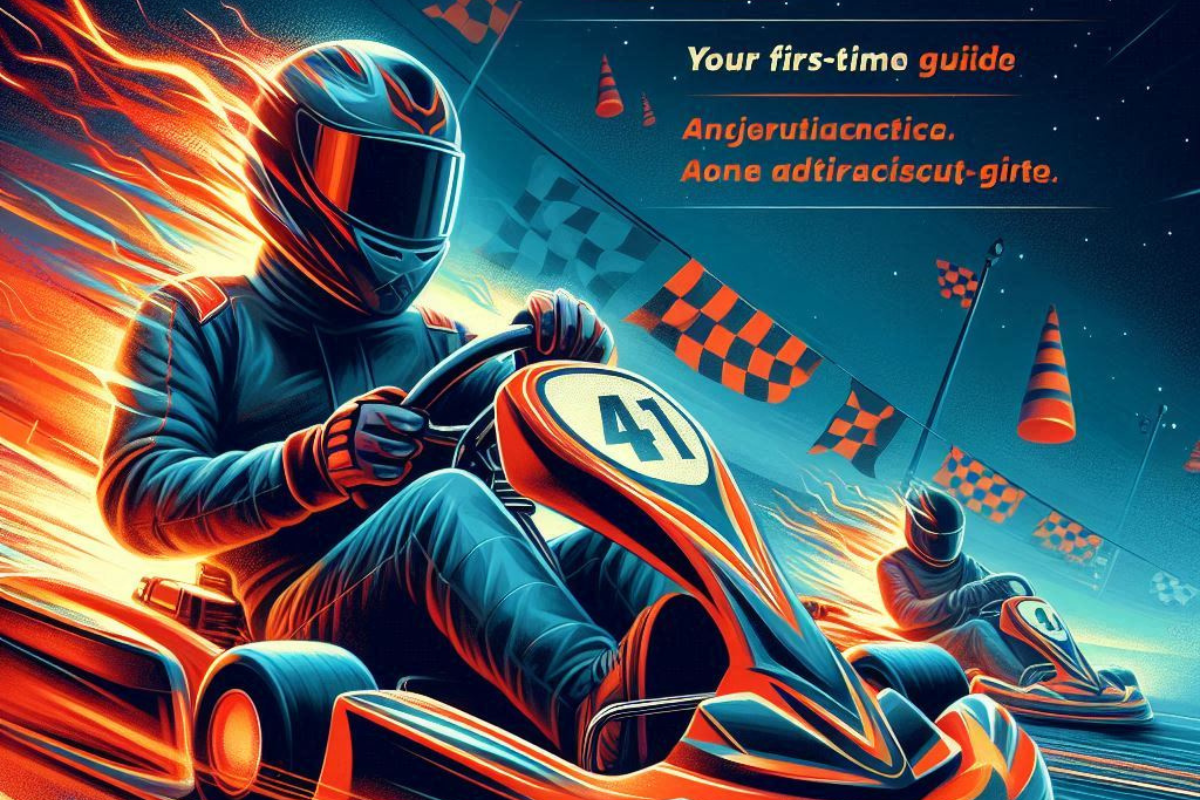The roar of the engines, the wind whipping past your helmet, the thrill of inching closer to the apex of a tight turn – go-karting is an exhilarating experience that offers a unique blend of fun, challenge, and pure, unadulterated speed. For many aspiring racers and casual thrill-seekers alike, it serves as the perfect gateway into the world of motorsports, providing a taste of high-octane competition and adrenaline-pumping excitement that few other activities can match. However, if you’re a first-timer, the prospect of strapping into a go-kart for the very first time might be accompanied by a few questions, or even a touch of pre-race jitters.
Fear not! This comprehensive guide has been meticulously crafted with you, the go-karting novice, in mind. We’ll demystify the karting experience, providing you with all the essential information you need to know, from preparing for your visit to the track to mastering the basic driving techniques and understanding what to expect on your big day. Get ready to banish those first-time anxieties, build your confidence, and make the absolute most of your inaugural go-karting adventure!
Why Go-Karting is the Perfect Entry Point to the World of Speed
Go-karting is far more than just a leisure activity; it’s an accessible and engaging sport that offers a plethora of benefits and thrilling sensations:
- Accessibility: Unlike many other forms of motorsports, you don’t need a special license or to own your own kart to get started. Rental kart tracks provide all the necessary equipment and facilities.
- Pure Adrenaline Rush: The low-to-the-ground seating position and the direct steering amplify the sensation of speed, delivering an unparalleled adrenaline rush that will leave you buzzing.
- Friendly Competition: It’s the ideal environment to challenge your friends, family, or even fellow first-timers in a safe and controlled setting, fostering a spirit of friendly rivalry.
- Skill Development: Go-karting hones your reflexes, hand-eye coordination, concentration, and strategic thinking – valuable skills that extend far beyond the racetrack.
- Safety: With proper safety equipment and clearly defined rules, go-karting is a surprisingly safe activity for beginners, allowing you to focus on the fun.
Before You Hit the Track: Essential Pre-Race Preparations
A little preparation can go a long way in ensuring a smooth and enjoyable first go-karting experience. Follow these essential tips before you arrive at the track:
- Choosing the Right Karting Facility:
- Indoor vs. Outdoor Tracks:
- Indoor: Covered tracks offer a controlled environment, shielded from the elements, often featuring tighter, more technical layouts that emphasize precise driving.
- Outdoor: Open-air tracks tend to be larger and longer, with more sweeping corners that allow for higher speeds, providing a more realistic motorsport feel.
- Research the Track’s Reputation: Check online reviews and ask for recommendations. A reputable track will have well-maintained karts and prioritize safety.
- Kart Types: Some facilities offer different types of karts for various age groups and skill levels. Confirm what type of kart you will be driving (e.g., adult karts, junior karts).
- Indoor vs. Outdoor Tracks:
- Appropriate Clothing and Footwear:
- Clothing: Opt for comfortable clothing that allows for a full range of motion. Avoid loose-fitting garments that could potentially get caught on any part of the kart. Jeans, t-shirts, and lightweight long-sleeved shirts are generally good choices.
- Footwear: Closed-toe shoes are absolutely mandatory for safety. Comfortable sneakers or trainers with good grip are ideal. Never wear sandals, flip-flops, high heels, or open-backed shoes.
- Hair: If you have long hair, make sure to tie it back securely. It is essential that all hair fits comfortably inside the helmet.
- Accessories: Remove any loose jewelry, scarves, dangling earrings, or items that could potentially fall off or become a hazard during your race.
- Hydration and Fuel:
- Ensure you are well-hydrated by drinking plenty of water before and after your go-karting session, especially if you’re racing outdoors on a warm day.
- Avoid eating a heavy meal immediately before getting behind the wheel. A light and easily digestible snack or meal is preferable to prevent discomfort.
- Check Track Requirements:
- Minimum Age and Height: All go-karting tracks have specific age and height restrictions in place to ensure the safety of all participants. Confirm these requirements before your visit, particularly if you are planning to go with younger individuals. Adult karts often have a minimum height requirement, typically around 4’7″ (140 cm).
Arriving at the Track: What to Expect on Race Day
The moment has arrived! But before you strap in and put the pedal to the metal, there are a few important steps you’ll typically go through at the go-karting facility:
- Check-in and Registration: Upon arrival, head to the registration desk. You will likely need to fill out a waiver form, providing your personal details and acknowledging the inherent risks associated with the activity. If you are part of a group, ensure everyone in your party completes the necessary paperwork.
- Safety Briefing: Before you get into a kart, you will almost certainly be required to attend a safety briefing conducted by track staff. Pay close attention to the instructions provided. This briefing will cover essential topics such as:
- Track Rules and Flags: Understanding the meaning of the different colored flags (e.g., green for go, yellow for caution, red for stop, blue for being lapped, black for a penalty) is crucial for safety and etiquette on the track.
- Kart Operation: You’ll learn the basics of how to operate the go-kart, including the functions of the accelerator and brake pedals, and the steering. Remember: usually, the right pedal is the accelerator, and the left pedal is the brake.
- Passing Rules: Understand the designated passing zones and the importance of safe and courteous overtaking maneuvers. Avoid aggressive or reckless driving.
- Emergency Procedures: Know what to do in case of a spin-out, collision, or any other unforeseen incident on the track.
- Helmet and Safety Gear Fitting: The track will provide you with a helmet that meets safety standards. Ensure that the helmet fits snugly but comfortably. It should not be too loose or too tight. Some tracks may also provide other safety gear such as neck braces or racing suits. Use all the safety equipment provided.
- Kart Assignment and Adjustment: You will be assigned a specific go-kart. Before your session begins, take a moment to familiarize yourself with the controls. Some karts may have adjustable seats and pedals. If needed, ask a track marshal for assistance in adjusting the kart to your reach and comfort.
Hitting the Track: Basic Go-Karting Techniques for Beginners
Now for the exciting part – getting behind the wheel! Here are some fundamental driving techniques to keep in mind during your first go-karting session:
- Smooth Steering: Avoid jerky or sudden steering movements. Steer smoothly and deliberately, anticipating the corners. Gentle inputs will help you maintain control and speed.
- Throttle and Braking: Apply the accelerator and brake pedals progressively. Avoid abrupt acceleration or hard braking, especially when entering corners. Smooth transitions between accelerating and braking will help you maintain momentum and stability.
- Cornering Techniques:
- “Outside-In-Outside” Line: For most corners, aim to start near the outside of the track, gradually steer towards the inside “apex” of the corner, and then drift back towards the outside as you exit the turn. This line generally allows for the smoothest and fastest passage through the corner.
- Look Ahead: Focus your vision far ahead on the track, looking through the corner to where you want to go. This will help you anticipate turns and react accordingly.
- Maintaining a Safe Distance: Keep a safe distance from the kart in front of you. This gives you time to react if they brake suddenly or encounter any issues.
- Respect the Flags and Track Marshals: Always obey the instructions given by the track marshals and be aware of the different colored flags. Slow down immediately if you see a yellow flag and come to a complete stop if you see a red flag.
- Relax and Have Fun! Remember that your first time is all about learning and enjoying the experience. Don’t put too much pressure on yourself to be the fastest driver right away. Focus on getting comfortable with the kart and the track.
Post-Race: Cooling Down and Reflecting on Your Experience
Once your go-karting session is over, take a moment to cool down and reflect on your experience:
- Cool Down: If you’ve been pushing yourself, take a few minutes to walk around and allow your heart rate to return to normal.
- Hydrate: Replenish any fluids you may have lost during your race.
- Share Your Experience: Talk to your friends or family about your go-karting session. Sharing your excitement and any challenges you faced can enhance the fun.
- Consider Future Sessions: If you enjoyed your first time (and most people do!), think about when you might want to go go-karting again. With each session, you’ll become more comfortable and improve your driving skills.
Embrace the Thrill of Your First Go-Karting Adventure
Your first go-karting experience is a moment to embrace the thrill of speed, the challenge of the track, and the pure joy of a unique and exhilarating activity. By preparing beforehand, understanding the safety procedures, and following the basic driving techniques, you’ll be well-equipped to have a fantastic and memorable time. So, take a deep breath, strap in, and get ready to unleash your inner speed demon. The checkered flag awaits!

Ramon Splinter is a passionate go-kart enthusiast and expert who shares valuable tips and insights on Zyorb, a blog dedicated to karting enthusiasts. With years of experience on the track, he specializes in helping beginners and seasoned drivers improve their skills, optimize their karts, and master racing strategies. His articles combine technical knowledge with practical advice, making go-karting more accessible and exciting for all.

